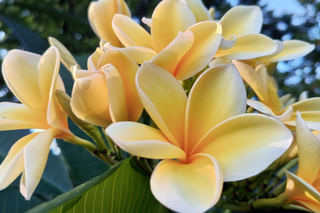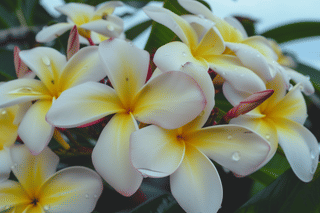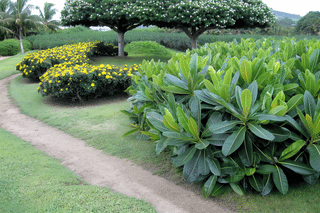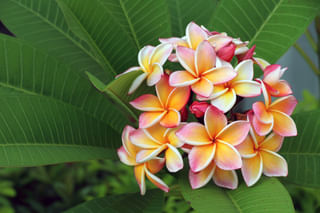How to care for a Plumeria plant
Learn essential tips and tricks for growing and maintaining a healthy Plumeria with this comprehensive plant care guide. From fertilizing and repotting to pest control and troubleshooting common issues, discover everything you need to know to keep your Plumeria thriving year-round. Perfect for both beginner and experienced gardeners.
Plumeria plants, or frangipani, are cherished for their gorgeous, fragrant flowers and tropical vibe. To keep them beautiful all year, they need proper care. This guide has got you covered with information on watering, sunlight, fertilizing, repotting, pest control, and more.
Let's get started!
Watering your Plumeria
Plumeria is a thirsty plant that needs a lot of water. But, it doesn't like growing in wet soil, otherwise it could develop root rot. So how do you give this plant enough water, without drowning it? Well, you can do two things:
- Get a pot with a drainage hole in the bottom to drain excess moisture from the pot
- Use well-draining soil that holds enough moisture for the flower to stay hydrated
Ideally, you should use a pot with a drainage hole and also use well-draining soil, because this gives you the best chance to avoid root rot.
In the spring and summer, you should water this plant regularly, once every 4-7 days. Before you water your Plumeria, make sure the soil has dried out. This plant loves moisture, but the soil should still mostly dry out before you water your plant again.
During the fall and winter, you can wait a little longer with watering: once every 7-10 days. Again, make sure the soil has dried out before you water your plant again. This will prevent root rot and other problems.
Sunlight requirements
If you've ever taken care of flowering plants before, you'll be very familiar with where to place Plumeria in your house: In the brightest spot you can find. Plumeria does best when you give it a spot where it gets at least 6 hours of direct sunlight per day, no matter what time of year.
Sunlight is key for Plumeria plants because it directly affects their ability to produce gorgeous, fragrant blooms. At least 6 hours of direct sunlight daily helps the plant photosynthesize efficiently, turning sunlight into the energy it needs to grow and thrive.
Without enough sunlight, Plumeria might not flower as much, and the plant can get leggy with weak, elongated stems. Besides boosting flowering, plenty of sunlight keeps the foliage healthy and the plant vigorous overall. So, if you want your Plumeria to flourish and brighten up your space with its tropical charm, make sure it gets lots of sunshine every day.
Ideal temperature range
Plumeria loves warm weather, with the sweet spot being between 65℉ and 80℉ (18℃ to 27℃). It's where they really thrive and show off their best blooms. When winter rolls around, make sure to protect your Plumeria from colder temperatures. If the temperature dips below 50℉ (10℃), you'll want to protect it to avoid any damage.
If you're growing these plants outside, you might want to bring them indoors if it's starting to get cold. This will protect it against any accidental freezing.
Fertilizing for optimal growth
To help your Plumeria thrive, make sure to fertilize properly. Being a flowering plant, Plumeria need quite a bit of fertilizer to stay healthy and grow their blooms. From spring to early fall, use a balanced fertilizer (NPK 11-11-13) every 2 weeks. Keep in mind, it's a good idea to cut back or stop fertilizing in late summer to help the plant prepare for dormancy.
I recommend using a water-soluble fertilizer, as this is very easy to use and gets absorbed into the soil quickly. Since every fertilizer is different, make sure to follow the instructions on the packaging for the best result. When you use the fertilizer, make sure to apply it directly to the soil and don't get it on the leaves.
When late fall and winter roll around, stop fertilizing altogether. You can start again in early spring when you see new growth. This routine will keep your Plumeria healthy and flourishing year-round!
Repotting your Plumeria
Repotting is crucial for healthy roots, and the best time to do it is early spring, right before new growth starts. It's super simple: just carefully take the plant out of its pot, check for any dead or rotting roots, and trim them. Then, pop it into a new pot with some well-draining soil. Make sure to water your plant after repotting to help the soil settle around Plumeria's roots.
While repotting your Plumeria is important, you don't need to do it too often. Every 2-3 years is usually perfect. This gives the plant enough time to grow and flourish without getting too cramped. Keep an eye on the roots through the drainage holes; if you spot roots poking out, it's a sign they need more room.
Also, if you notice your plant isn't growing as vigorously or the soil looks compacted and isn't draining well, it might be time for a new pot sooner.
Pest control

Plumeria plants can unfortunately attract a few of pests like mealybugs, spider mites, aphids, whiteflies, and scale. These pests often show up if the plant isn't getting enough water or sunlight, making it weaker and more vulnerable. To keep your plumeria in good shape, it's a good idea to check it regularly and catch any issues early before they get out of hand.
For mealybugs, which look like little white cotton balls, you can use a cotton swab dipped in alcohol to wipe them off. Spider mites, which are almost too small to see, can be handled with a strong water spray or some insecticidal soap. Aphids, those tiny green, black, or brown bugs, can also be dealt with using neem oil or insecticidal soap. A mix of liquid dish soap (1-2 tablespoons per gallon of water) works well for a variety of these pests too.
In the fall, plumerias might get a "rust" fungus, showing up as yellow or orange spots on the underside of the leaves. This usually happens due to poor air circulation and too much moisture on the leaves, but is often not a problem. You can trim these leaves and improve the air circulation to help your plant.
Propagation
Propagating plumeria is a fun and rewarding way to get more of these beautiful plants without having to buy new ones. The most common method is by using cuttings, which is simpler than you might think.
Start by choosing a healthy, mature branch, preferably around 12 to 18 inches long. Make a clean cut with a sharp knife or pruners, and then let the cutting dry out for about a week. The drying process helps callous the cut end, reducing the risk of rot when you plant it.
After letting the cutting dry for a week, you should remove all of the leaves on the cutting, as these will use to much energy and your cutting has to focus on growing roots.
Once your cutting has calloused, it's time to plant it. Fill a pot with well-draining soil – a cactus or succulent mix works great. Stick the cutting about 2-3 inches deep into the soil, making sure it's standing upright. Water the soil lightly and put the pot in a warm, sunny spot. Be patient; it may take a few weeks for roots to start growing. During this time, avoid overwatering; let the soil dry out between waterings to prevent rot.
You'll know your cutting has successfully rooted when you see new leaves starting to sprout. This means it's time to gradually increase watering and perhaps even move your new plumeria to a bigger pot.
Common issues
Even with the best care, Plumeria plants can still run into some bumps along the way. These are some of the most common problems:
Root rot
This happens when you overwater, especially when the plant is dormant. To fix it, just cut back on the watering and make sure the soil dries out between each watering session. Using a pot with a drainage hole and well-draining soil is your best chance to prevent root rot.
Leaf drop
If you notice leaves dropping, it's likely due to sudden temperature changes or not enough sunlight. Keep the temperatures steady and make sure your plumeria gets plenty of light. Keep the plant away from cold or warm drafts, AC units, and heating vents.
Failure to flower
When your plant isn't flowering, it could be missing out on sunlight, getting too much nitrogen in its fertilizer, or not having a proper dormancy period. Make sure it gets at least 6 hours of sun, use a balanced fertilizer, and give it a rest period.
Toxicity for pets
Plumeria plants are toxic to pets if eaten. The sap and other parts contain compounds that can cause vomiting, diarrhea, and other serious health issues in animals. To keep your pets safe, make sure the plant is out of their reach. Try placing it somewhere they can't get to or use barriers to keep them away.
Conclusion
In conclusion, growing a Plumeria can be a truly rewarding experience. With a little care and attention, you'll be able to enjoy its stunning blooms and tropical vibe all year round.
Just remember the basics: plenty of sunlight, proper watering, regular fertilizing, and keeping an eye on pests. Don't stress too much if you encounter some common issues along the way. Every plant has its quirks, and learning how to manage them is part of the fun.
Thank you for reading this post! I hope it helps you to keep your plants healthy and beautiful! If you're looking for more guides on specific plants, you can always request a plant guide to get a guide for the plant you have trouble with.
Test your plant care knowledge
Quiz completed!
Want to learn more? Sign up for my newsletter to receive free tips in your inbox!
Sign up now!









